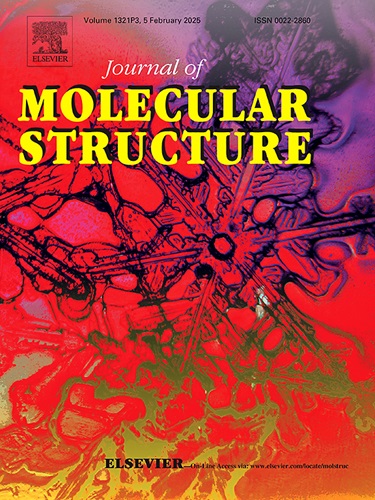Synthesis, characterization, computational studies and biological activities of novel NHC precursor and its silver (I) and selenium compounds
IF 4
2区 化学
Q2 CHEMISTRY, PHYSICAL
引用次数: 0
Abstract
The potential applications of fluorine in drug design are expanding rapidly. The evolution of synthetic methodologies has engendered the conception of novel fluorinated motifs. In the present study, the effective use of N-heterocyclic carbenes (NHCs) in pharmaceutical chemistry was combined with the enhancing role of fluorine groups in bioactivity, and the synthesis of a new NHC precursor (1) containing 2,6-difluorobenzyl group was achieved. Respective Ag-NHC (2) and Se-NHC (3) compounds were prepared from the synthesized NHC precursor. Structural characterization of each compound (1-3) was conducted by 1H, 13C and 19F NMR, FT-IR, UV-visible spectroscopy, and elemental analysis methods. The antioxidant activity of these compounds was evaluated by using ABTS and DPPH radical scavenging assays as well as their ability to inhibit the acetylcholine esterase (AChE) enzyme. Besides, density functional theory (DFT) computations were performed in order to comparatively peruse the molecular structures, electronic properties, reactivity tendencies, donor-acceptor interactions, and electrostatic surface properties of compounds 1-3 for both vacuum and CHCl3 phase. The reactivity ranking for the gas phase was clearly determined to be 3 < 2 < 1, based on the calculated energy gap values. The excited state characteristics of 1-3 in CHCl3 were calculated by the TD-DFT method. The antioxidant activity showed that the compounds, particularly compound 3 displayed effective antioxidant activities. According to the enzyme inhibition outcomes, compound 2 (IC50 value 8.43 ± 0.71 μM) had the most effective AChE inhibition among the synthesized compounds. Taken together, this investigation revealed the synthesis, characterization of various novel compounds (1-3) with, antioxidant potentials, AChE inhibitory activities, and quantum chemical calculations.
新型NHC前体及其银(I)和硒化合物的合成、表征、计算研究和生物活性
氟在药物设计中的潜在应用正在迅速扩大。合成方法的发展产生了新型氟化基元的概念。本研究将n -杂环羰基(NHCs)在药物化学中的有效利用与氟基团对生物活性的增强作用结合起来,合成了一种新的含2,6-二氟苯基的NHCs前体(1)。由合成的NHC前驱体分别制备Ag-NHC(2)和Se-NHC(3)化合物。每个化合物(1-3)的结构通过1H, 13C和19F NMR, FT-IR, uv -可见光谱和元素分析方法进行了表征。通过ABTS和DPPH自由基清除实验以及对乙酰胆碱酯酶(AChE)的抑制能力来评估这些化合物的抗氧化活性。此外,通过密度泛函理论(DFT)计算比较了化合物1-3在真空相和CHCl3相的分子结构、电子性质、反应性倾向、供体-受体相互作用和静电表面性质。气相的反应性等级确定为3 <;2 & lt;1、根据计算出的能隙值。用TD-DFT方法计算了CHCl3中1-3的激发态特性。抗氧化活性表明,化合物3具有较强的抗氧化活性。从酶抑制效果来看,化合物2 (IC50值为8.43±0.71 μM)对乙酰胆碱酯酶的抑制效果最好。综上所述,本研究揭示了各种新化合物(1-3)的合成、表征、抗氧化潜力、AChE抑制活性和量子化学计算。
本文章由计算机程序翻译,如有差异,请以英文原文为准。
求助全文
约1分钟内获得全文
求助全文
来源期刊

Journal of Molecular Structure
化学-物理化学
CiteScore
7.10
自引率
15.80%
发文量
2384
审稿时长
45 days
期刊介绍:
The Journal of Molecular Structure is dedicated to the publication of full-length articles and review papers, providing important new structural information on all types of chemical species including:
• Stable and unstable molecules in all types of environments (vapour, molecular beam, liquid, solution, liquid crystal, solid state, matrix-isolated, surface-absorbed etc.)
• Chemical intermediates
• Molecules in excited states
• Biological molecules
• Polymers.
The methods used may include any combination of spectroscopic and non-spectroscopic techniques, for example:
• Infrared spectroscopy (mid, far, near)
• Raman spectroscopy and non-linear Raman methods (CARS, etc.)
• Electronic absorption spectroscopy
• Optical rotatory dispersion and circular dichroism
• Fluorescence and phosphorescence techniques
• Electron spectroscopies (PES, XPS), EXAFS, etc.
• Microwave spectroscopy
• Electron diffraction
• NMR and ESR spectroscopies
• Mössbauer spectroscopy
• X-ray crystallography
• Charge Density Analyses
• Computational Studies (supplementing experimental methods)
We encourage publications combining theoretical and experimental approaches. The structural insights gained by the studies should be correlated with the properties, activity and/ or reactivity of the molecule under investigation and the relevance of this molecule and its implications should be discussed.
 求助内容:
求助内容: 应助结果提醒方式:
应助结果提醒方式:


